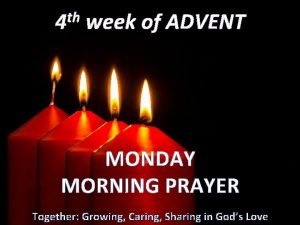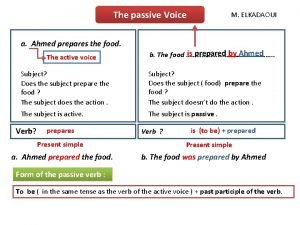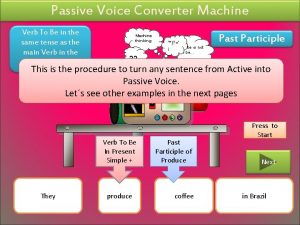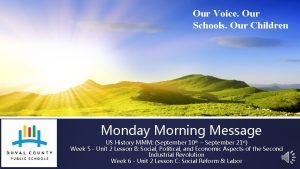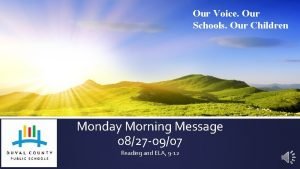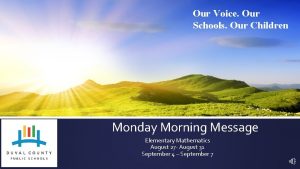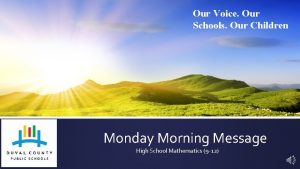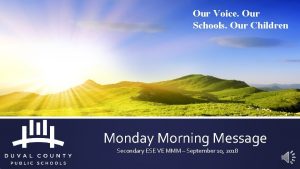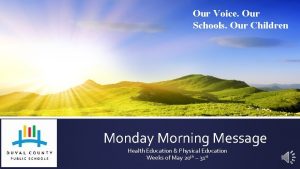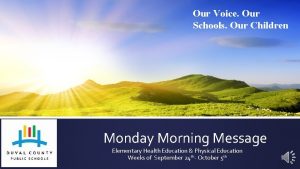Our Voice Our Schools Our Children Monday Morning





















- Slides: 21

Our Voice. Our Schools. Our Children Monday Morning Message US History MMM: (August 27 th – September 7 th) Week 3 - Unit 1 Lesson D: Reconstruction and the Outcome of the Civil War Week 4 - Unit 2 Lesson A: Westward Expansion & Agricultural Impact on Economy

August 27 th – September 7 th 2018 Matt Campese Executive Director Campese. M@duvalschools. org Ti. Lena Robinson Specialist (High School) washingtot 2@duvalsch ools. org 904 -390 -2925 La. Shawna Campbell Specialist (Middle School) irbyl 1@duvalschools. org

Standards Unit 1 Lesson D: SS. 912. A. 2. 2: Assess the influence of significant people or groups on Reconstruction. Test Item Remarks/Examples: May include, but are not limited to, Andrew Johnson, Radical Republicans, Jefferson Davis, Frederick Douglass, Ulysses S. Grant, Robert E. Lee, William T. Sherman, Buffalo Soldiers, Harriet Tubman, and Sojourner Truth. SS. 912. A. 2. 3: Describe the issues that divided Republicans during the early Reconstruction era. Test Item Remarks/Examples: May include, but are not limited to, the impeachment of Andrew Johnson, southern whites, black legislators and white extremist organizations such as the KKK, Knights of the White Camellia, the White League, Red Shirts, and Pale Faces. SS. 912. A. 2. 4: Distinguish the freedoms guaranteed to African Americans and other groups with the 13 th, 14 th, and 15 th Amendments to the Constitution. SS. 912. A. 2. 5: Assess how Jim Crow Laws influenced life for African Americans and other racial/ethnic minority groups. SS. 912. A. 2. 6: Compare the effects of the Black Codes and the Nadir on freed people, and analyze the sharecropping system and debt peonage as practiced in the United

Standards Unit 2 Lesson A: SS. 912. A. 2. 7: Review the Native American experience. Test Item Remarks/Examples: May include, but are not limited to, westward expansion, reservation system, the Dawes Act, Wounded Knee Massacre, Sand Creek Massacre, Battle of Little Bighorn, Indian Schools, government involvement in the killing of buffalo. SS. 912. A. 3. 1: Analyze the economic challenges to American farmers and framers’ responses to these challenges in the mid to late 1800 s. Test Item Remarks/Examples: May include, but are not limited to, creation of agricultural colleges, Morrill Land Grant Act, gold standard and bimetallism, the creation of the Populist Party. SS. 912. A. 3. 6: Analyze the changes that occurred as the united States shifted from an agrarian to an industrial society. Test Item Remarks/Examples: May include, but are not limited to, Social Darwinism, laissez-faire, government regulations of food and drugs, migration to cities, changes to the family structure, Ellis Island, Angel Island, push-pull factors.

Objectives Unit 1 Lesson D 1. 5 class periods Students will: • Identify the economic, political, and /or social consequences of Reconstruction. • Identify and/or categorize the influence of significant people or groups on Reconstruction. • Describe the issues that divided Republicans during the early Reconstruction era. • Analyze how Jim Crow Laws influenced life for African Americans and other racial/ethnic minority groups.

Objectives Unit 2 Lesson A 2 class periods Students will: • Review the reasons for westward migration. • Examine the conflict with Native Americans. • Analyze the challenges facing American farmers and the farmers’ responses to those challenges. • Evaluate the importance of abundant natural resources and raw materials in promoting the Second Industrial Revolution. • Evaluate the role that the farming boom played in promoting the Second Industrial Revolution.

Focus Unit 1 Lesson D : Understand how the Civil War and Reconstruction impacted the United States socially, politically, and economically. Identify key figures of the Reconstruction era and assess how their actions and/or policies contributed to the successes or failures of Reconstruction. Unit 2 Lesson A: The Native American experience, how settlement affected the relationship between settlers and Native Americans, the way of life of Native Americans as it relates to the shifts caused by westward expansion, and the economic challenges that farmers faced. Identify the factors that prepared the way for America’s Second Industrial Revolution and understand the changes that took place as the United States moved from an agricultural to industrial society. Resources: ▪ Textbook: Florida United States History & Geography, Modern Times; Mc. Graw Hill (2013): Chapter 1, Lesson 5 (pages 63 - 69) Chapter 2, Lesson 2 (pages 80 – 82) Chapter 2, Lesson 3 (pages 83 – 87) ▪ Gateway to U. S. History (Jarrett and Yahng, 2014) Chapter 2: Reconstruction: America’s “Unfinished Revolution”? (pages 23 - 34) Chapter 3: “Go West!” (pages 41 – 53) Chapter 4: The Triumph of Industry (pages 59 – 75)

Content Focus Breakdown

Content Focus Breakdown

Content Focus Breakdown

Content Focus Breakdown

Content Focus Breakdown

Content Focus Breakdown

Content Focus Breakdown

Content Focus Breakdown

Gradual Release Unit 1 Lesson D After the bell ringer, as best practices for the “I Do”: The teacher identifies the four main plans for Reconstruction and details President Lincoln’s Plan. For the “We Do, ” the teacher and students read and identify details from the text that describes the Reconstruction plans and policies of President Johnson, the Southern states, and the Radical Republicans and record the details in the appropriate columns of the chart.

Gradual Release For the “They Do, ” students work together to identify key details about the social, political, and economic changes that occurred in the South during and after Reconstruction as they read assigned passages. Independently (“You Do”) students will use the information from their notes to: • write a journal entry from the viewpoint of a white Southerner or African American freedmen reflecting on the social, political, and economic changes that occurred in the South during and after Reconstruction. or • write an editorial detailing how significant individuals or groups (at least 3) contributed to the successes and/or failures of Reconstruction.

What Administrators Should See ▪ Students engaged in meaningful tasks and are taking ownership of their learning. ▪ Best practices in the US History classroom would include the appropriate pacing for the Gradual Release Model as well as the consistent use of student collaborative tasks, student discourse, and the critical alignment to our Standards and Test Item Specifications on a daily basis. ▪ Baseline assessments should be completed between August 15 th – September 7 th.

Common Misconceptions Students may believe: ▪ that Reconstruction was a failure because African Americans did not gain social and economic equality or retain their political rights. While Reconstruction did not change the mind-set of many white Southerners, many African Americans exercised their right to vote for the first time and some held political positions at the state and federal levels. ▪ the withdrawal of federal troops in the South which resulted from the Compromise of 1877 immediately changed race relations in the South. However, African Americans continued to vote in the South until 1890. State laws were passed to revoke the right and privileges that had been granted to Africans and the “Jim Crow” South gradually emerged. ▪ that homesteaders settled an empty, barren land. Although it is true that homesteaders encountered a harsh wilderness, the land was alive with plants, animals, and Native peoples. ▪ that conflict only existed between settlers and Native Americans, when in reality settlers from the East sometimes clashed with Hispanic residents over land as the settlers expanded their herds and claimed large tracts of land. ▪ the developments taking place in the West happened after the Civil War was over, when in reality they were happening at the same time.

Professional Learning Opportunities ▪ U. S. History Social Studies Meeting, Tuesday, October 30, 2018. ▪ Time: 7: 30 am – 2: 30 pm ▪ Location: Ed White High School (Houston Hall)

If everyone is moving forward together, then success takes care of itself Have a Great Week! For More Information Contact Matt Campese, Executive Director Closing Message Ti. Lena Robinson, Specialist (High School) La. Shawna Campbell, Specialist (Middle School) - Henry Ford
 Monday morning prayer
Monday morning prayer Come monday morning
Come monday morning Good morning december
Good morning december Powerschool huntsville
Powerschool huntsville Reach schools safety schools and
Reach schools safety schools and Place value chart for class 4
Place value chart for class 4 Good morning everyone and welcome to my presentation
Good morning everyone and welcome to my presentation Good morning english class
Good morning english class Good morning i'm glad to see you
Good morning i'm glad to see you Are you sleeping brother john drawing
Are you sleeping brother john drawing Hi good morning
Hi good morning Good afternoon my dear students
Good afternoon my dear students Hello good afternoon teacher
Hello good afternoon teacher Nobody loves me like you love me jesus
Nobody loves me like you love me jesus Paragraph about food in the past
Paragraph about food in the past Passive voice past tense examples
Passive voice past tense examples Aktiv passiv voice
Aktiv passiv voice Active to passive voice converter
Active to passive voice converter Future simple passive voice examples
Future simple passive voice examples Active and passive voice lesson
Active and passive voice lesson Our failing schools enough is enough summary
Our failing schools enough is enough summary Our failing schools enough is enough summary
Our failing schools enough is enough summary
